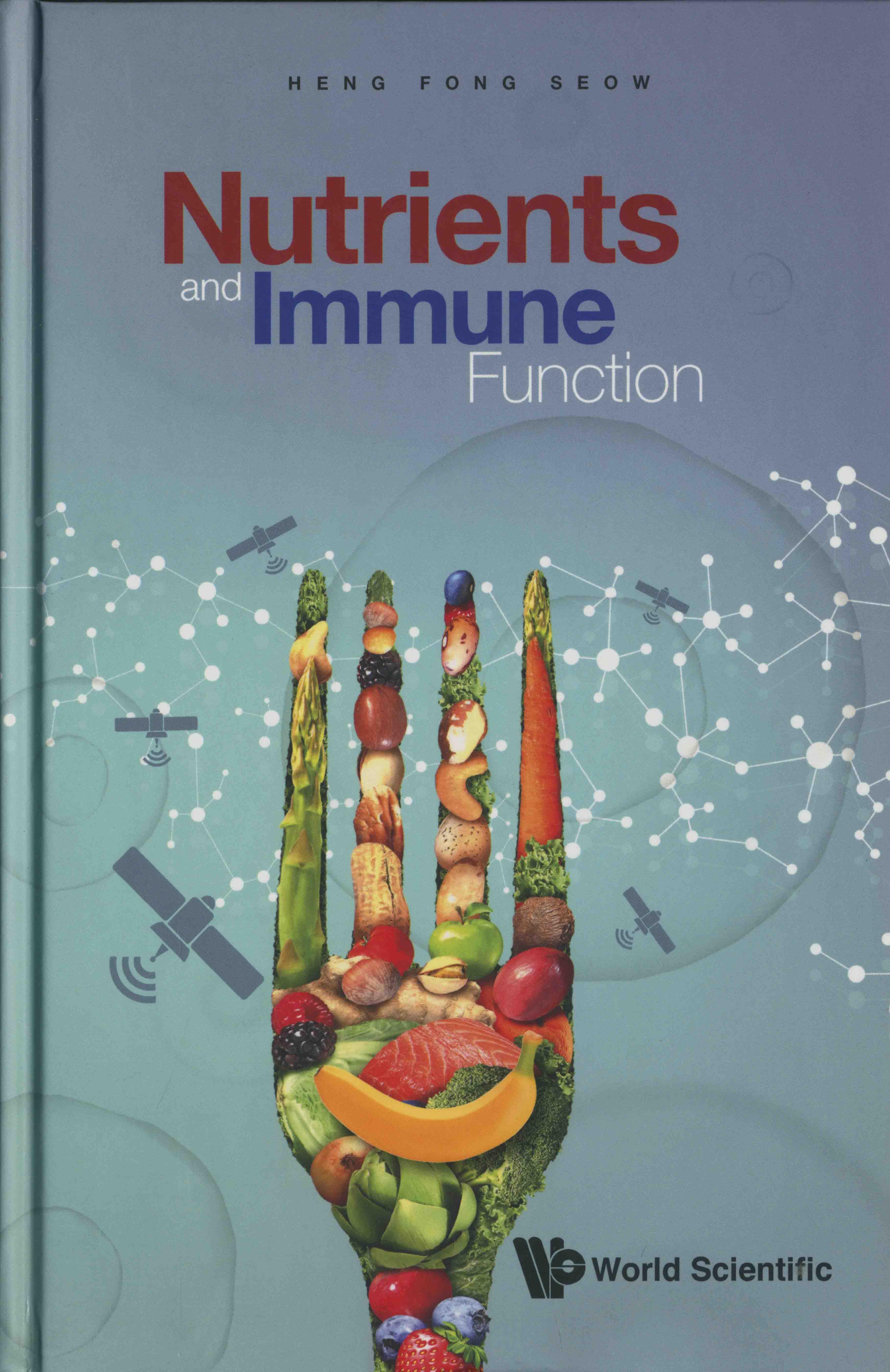 |
Nutrients and immune function / Heng Fong Seow, Universiti Putra Malaysia, Malaysia. -- New Jersey : World Scientific, [2021]. – (63.17038/S478) |
Contents
Preface
Chapter 1 Elements of the immune system
1.1 0rganisation of the immune system: Lymphatic system
1.2 Primary lymphoid organs
1.3 Secondary lymphoid organ: Lymph nodes
1.4 Secondary lymphoid tissue: Spleen
1.5 Cytokines as communicators of the immune system
1.6 Mechanism of action of cytokines
1.7 Role of adhesion molecules in immune responses
1.8 Complement
1.9 Lines of defence in the immune system
1.10 Origin of cells of the immune system
1.11 Cells of the innate immune system
1.12 Cells of the adaptive immune system
1.13 T cell receptor
1.14 B cell receptor
1.15 The functions of CD4+ T helper cells are to
1.16 The functions of cytotoxic T cells
1.17 B lymphocytes and antibody production
1.18 Antibodies
1.19 Gastrointestinal immune system
1.20 Antigen recognition, lymphocyte activation and differentiation
1.21 Vitamins such as vitamins A and D can influence T cell differentiation
1.22 Nutrient imbalance and immune function
Chapter 2 Vitamins
2.1 Introduction
2.2 Vitamin A
2.3 Vitamin B
2.4 Vitamin C
2.5 Vitamin D
2.6 Vitamin E
Chapter 3 Minerals and immune function
3.1 Introduction
3.2 Functions of minerals: Overview
3.3 Magnesium
3.4 Iron
3.5 Zinc
3.6 Copper
3.7 Manganese
3.8 Selenium
3.9 Iodine
3.10 Chromium
3.11 Fluoride
3.12 Other trace minerals
Chapter 4 Fatty acids and inflammation
4.1 Introduction
4.2 Types of fats
4.3 Structure of fats
4.4 Cis and trans fatty acids: Differences
4.5 Why is consumption of trans fatty acids not beneficial?
4.6 Why is high fat intake not beneficial?
4.7 Classification of PUFAs as (0-3 or (0-6
4.8 Dietary sources of monounsaturated and polyunsaturated fatty acids
4.9 Metabolism of LA and ALA
4.10 Metabolism of arachidonic acid
4.11 Metabolism of EPA and DHA to pro-resolving lipid mediators
4.12 Roles of SPMs in inflammation and the adaptive immune responses
4.13 Modulation of the immune system by (0-3 PUFAs
4.14 Saturated fatty acids and inflammation
4.15 Dietary fat, Mediterranean diet and health
4.16 Is supplementation with (0-3 PUFAs beneficial for patients with chronic inflammatory conditions?
Chapter 5 Food allergy
5.1 Introduction
5.2 Mechanisms of allergic response to food allergens
5.3 Food intolerance
5.4 Factors that contribute to food allergy: Atopy
5.5 Early introduction to foods
5.6 Level of consumption
5.7 Novel foods
5.8 Effect of heat, digestion and food processing techniques on allergenicity
5.9 Diagnosis of food allergy
5.10 Prevention and management of food allergy prevention
5.11 Management and treatment of food allergy
Chapter 6 Probiotics and prebiotics
6.1 Introduction to gut microbiota
6.2 Probiotics
6.3 Prebiotics
6.4 Synbiotics
Chapter 7 Autoimmunity and nutrition
7.1 Introduction
7.2 Immunological basis of self-tolerance
7.3 Immunological basis for loss of self-tolerance
7.4 Influence of nutrition on the onset and progression of autoimmune diseases
7.5 Type I diabetes mellitus
7.6 Rheumatoid arthritis
7.7 Vitamin A contributes to balance of Thl7/Tregs and downregulation of antibody production
7.8 Systemic Lupus Erythematosus (SLE)
7.9 Autoimmune thyroid diseases and micronutrients
Chapter 8 Nutrition, diet and cancer
8.1 Introduction
8.2 Association between infectious agents and cancer
8.3 Relationship between inflammation and cancer
8.4 Factors that influence cancer risk
8.5 Carcinogens in the diet
8.6 Role of folate (vitamin B9), vitamin D and vitamin A in cell proliferation
8.7 Antioxidants and minimising cancer risk
8.8 Folate and cancer
8.9 Polyunsaturated Fatty Acids (PUFAs): Beneficial or harmful?
8.10 Dietary fibre and cancer risk reduction
8.11 Effects of dietary fibre on immunity and gut microbiota
8.12 Effects of dietary fats and proteins on gut microbiota
8.13 Natural products/compounds and cancer
8.14 How do micronutrients enhance tumour immunity?
8.15 Immunonutritional support for cancer patients
Chapter 9 Exercise immunology
9.1 Health impact of moderate exercise
9.2 Health impact of intense, prolonged or exhaustive physical exercise
9.3 Exercise and hormones
9.4 Benefits of training exercise for performance
9.5 Inflammation, stress and muscle damage
9.6 Immune changes in exercise
9.7 Impact of exercise in chronic metabolic diseases
9.8 Exercise and cancer
9.9 Immunonutritional support for elite athletes
Chapter 10 Immunonutrition in the elderly and critically ill patients
10.1 Introduction
10.2 Oxidative stress in aging
10.3 Interventions to mitigate oxidative stress
10.4 Age-related changes in the immune system
10.5 Micronutrient deficiencies in the elderly
10.6 Impact of micronutrients, probiotics and prebiotics on immunity in the elderly
10.7 Examples of health problems associated with micronutrient deficiencies
10.8 Immunonutrition for critically ill patients
Recommended readings and references
Glossary
Index